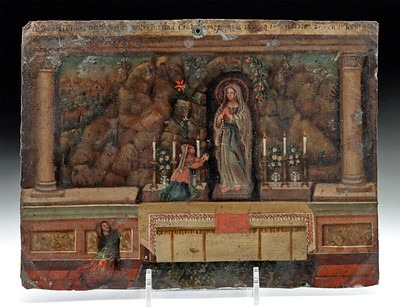Gandharan Necklace w/ Glass & Gold Beads
Lot 90
About Seller
Artemis Fine Arts
686 S Taylor Ave, Ste 106
Louisville, CO 80027
United States
Selling antiquities, ancient and ethnographic art online since 1993, Artemis Gallery specializes in Classical Antiquities (Egyptian, Greek, Roman, Near Eastern), Asian, Pre-Columbian, African / Tribal / Oceanographic art. Our extensive inventory includes pottery, stone, metal, wood, glass and textil...Read more
Categories
Estimate:
$1,600 - $2,400
Absentee vs Live bid
Two ways to bid:
- Leave a max absentee bid and the platform will bid on your behalf up to your maximum bid during the live auction.
- Bid live during the auction and your bids will be submitted real-time to the auctioneer.
Bid Increments
| Price | Bid Increment |
|---|---|
| $0 | $25 |
| $300 | $50 |
| $1,000 | $100 |
| $2,000 | $250 |
| $5,000 | $500 |
| $10,000 | $1,000 |
| $20,000 | $2,500 |
| $50,000 | $5,000 |
| $100,000 | $10,000 |
| $200,000 | $20,000 |
About Auction
By Artemis Fine Arts
Jun 15, 2023
Set Reminder
2023-06-15 10:00:00
2023-06-15 10:00:00
America/New_York
Bidsquare
Bidsquare : VARIETY Ancient, Ethno, Native American, Fine Art
https://www.bidsquare.com/auctions/artemis-gallery/variety-ancient-ethno-native-american-fine-art-12990
Antiquities, ethnographic, native american and fine art from cultures encompassing the globe. Artemis Fine Arts info@artemisgallery.com
Antiquities, ethnographic, native american and fine art from cultures encompassing the globe. Artemis Fine Arts info@artemisgallery.com
- Lot Description
Central Asia, Pakistan and Afghanistan, Gandharan Empire, ca. 200 BCE to 100 CE. A stunning necklace comprised of 10 bell-shaped beads made from 87.5% gold (equivalent to 21K) with detailing and forms that suggest they may be variants of stupas and 54 glass tubular beads presenting beautiful spring green hues. Interestingly, gold was not readily available in the ancient region of Gandhara and probably came to Gandhara via trade with the Mediterranean. Given this, such jewelry would have served as a grand statement of the wearer's social status. A lovely work of wearable art that is certain to make heads turn! Size: 19" L (48.3 cm); (gold beads): 0.75" L x 0.375" Diameter (1.9 cm x 1 cm); (glass beads): 0.25" L (0.6 cm); gold quality: 87.5% (equivalent to 21K)
Representations of jewelry on ancient Kushan statues demonstrates these peoples' desire to embellish individuals with all sorts of baubles. Whereas wearing jewelry was a practice reserved for women prior to and following the Kushans, both men and women wore jewelry in Kushan society. Just how lavish and luxurious the jewelry was depended on the social status of the owner. The most extravagant jewelry was worn by kings and queens, those of regal birth, as well as deities and bodhisattvas.
Provenance: East Coast collection, New York Gallery, New York City, New York, USA, acquired before 2010
All items legal to buy/sell under U.S. Statute covering cultural patrimony Code 2600, CHAPTER 14, and are guaranteed to be as described or your money back.
A Certificate of Authenticity will accompany all winning bids.
We ship worldwide and handle all shipping in-house for your convenience.
#151670Wearable as shown and strung in modern times. Glass and gold beads are ancient, and stringing is modern. Scuffs and minute nicks to peripheries of glass beads. Gold beads are intact and in fabulous condition.Condition
- Shipping Info
-
All shipping is handled in-house for your convenience. Your invoice from Artemis Gallery will include shipping calculation instructions. If in doubt, please inquire BEFORE bidding for estimated shipping costs for individual items.
-
- Buyer's Premium



 EUR
EUR CAD
CAD AUD
AUD GBP
GBP MXN
MXN HKD
HKD CNY
CNY MYR
MYR SEK
SEK SGD
SGD CHF
CHF THB
THB














